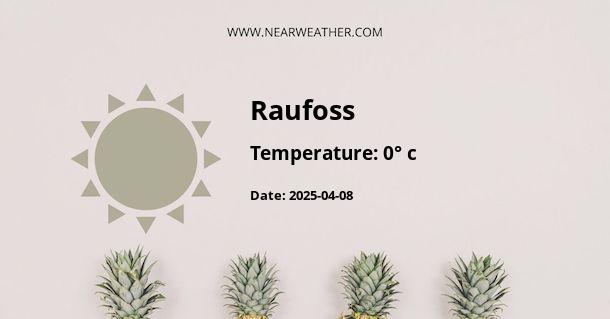Raufoss, Norway: Climate and Weather Year Round
Raufoss is a picturesque town located in the Vestre Toten municipality of Norway. Situated in the Oppland county, Raufoss experiences a unique climate that is influenced by its geographical location and proximity to the Gjøvik region. In this article, we will explore the climate and weather patterns of Raufoss throughout the year, providing detailed and accurate information for residents and visitors alike.
Geographical Factors
Raufoss sits at a latitude of approximately 60 degrees north, which places it within the subarctic climate zone. The town is nestled between the stunning Lake Mjøsa and the surrounding hills, adding to its natural beauty. The nearby Gjøvik region also plays a role in shaping Raufoss' climate, as it affects the air masses and weather patterns that move through the area.
Temperatures
The average annual temperature in Raufoss is around 4 degrees Celsius (39 degrees Fahrenheit). However, the town experiences distinct seasonal variations in temperature.
In the winter months of December to February, temperatures can drop to an average low of -8 degrees Celsius (17 degrees Fahrenheit). Snowfall is common during these months, creating a scenic winter wonderland.
Spring, which spans from March to May, sees a gradual increase in temperatures. The average high temperature during this season ranges from 4 to 12 degrees Celsius (39 to 54 degrees Fahrenheit), while the average low hovers between -2 to 4 degrees Celsius (28 to 39 degrees Fahrenheit).
Summer in Raufoss, from June to August, brings milder temperatures and longer daylight hours. The average high during this season reaches around 20 degrees Celsius (68 degrees Fahrenheit), with occasional peaks in the mid-20s (mid-70s Fahrenheit). The average low stays around 9 degrees Celsius (48 degrees Fahrenheit).
Autumn, spanning September to November, witnesses a gradual drop in temperatures. The average high temperature ranges from 14 to 7 degrees Celsius (57 to 45 degrees Fahrenheit), while the average low fluctuates between 5 to -1 degrees Celsius (41 to 30 degrees Fahrenheit).
Precipitation
Raufoss experiences a moderate amount of precipitation throughout the year, with the majority falling as rain. The town receives an average of 900 to 1000 millimeters (35 to 39 inches) of precipitation annually.
The wettest months are typically July and August, coinciding with the summer season. These months receive an average of 100 to 120 millimeters (4 to 5 inches) of rainfall.
Winter months, particularly December and January, witness snowfall, adding to the overall precipitation levels. Snow can accumulate to an average depth of 20 to 30 centimeters (8 to 12 inches) during these months.
Sunlight
Due to its northern latitude, Raufoss experiences significant variations in daylight hours throughout the year. The town enjoys long summer days, with the sun setting as late as 11 PM and rising as early as 3 AM. This provides ample time for outdoor activities and exploration during the summer months.
On the other hand, winter brings shorter days, with the sun rising around 9 AM and setting as early as 3 PM. This limited daylight can create a cozy and intimate atmosphere, perfect for enjoying indoor activities and the beauty of the surrounding winter landscape.
Wind
Raufoss is known for its relatively calm winds throughout the year. The surrounding hills and geographical features provide natural protection against strong gusts. However, occasional breezes can be experienced, especially during the summer months.
It is worth noting that wind conditions can vary in different parts of the town, with areas closer to Lake Mjøsa potentially experiencing slightly stronger winds due to the lake's influence.
Climate Change and Future Projections
Like many other regions around the world, Raufoss is not immune to the effects of climate change. Rising global temperatures and changing weather patterns have the potential to impact the town's climate in the future.
According to climate projections, Raufoss may experience milder winters, with reduced snowfall and more frequent winter rain events. Summers could become warmer, potentially reaching higher temperatures than the current averages.
These projections emphasize the importance of sustainable practices and efforts to mitigate climate change to preserve the unique climate and natural beauty of Raufoss for future generations.
Conclusion
Raufoss, Norway, boasts a subarctic climate influenced by its geographical location and proximity to the Gjøvik region. With distinct seasonal variations, including cold winters with snowfall and mild summers with longer daylight hours, the town offers a diverse climate experience throughout the year.
While precipitation levels remain moderate, Raufoss sees a higher amount of rainfall during the summer months and snowfall during winter. The town enjoys relatively calm winds, with occasional summer breezes.
As climate change continues to affect the world, Raufoss could experience milder winters and warmer summers in the future. It is crucial to prioritize sustainability and environmental consciousness to protect the unique climate and natural beauty of this charming Norwegian town.
A - Raufoss's Latitude is 60.726379 & Longitude is 10.617180.
A - Weather in Raufoss is 0° today.
A - Climate Conditions in Raufoss shows broken clouds today.
A - Humidity in Raufoss is 80% today.
A - Wind speed in Raufoss is 3.74 km/h, flowing at 280° wind direction. today.
